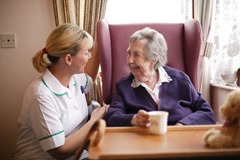Northern Ireland’s ageing trends
 agendaNi considers the projections for older people, who tend to require most care.
agendaNi considers the projections for older people, who tend to require most care.
Older people account for 60 per cent of acute hospital cases in Northern Ireland, and the level of care that they will need is due to increase as the overall population ages. The province has the fastest growing group of older people in the UK, as its population structure has traditionally been younger than that of Great Britain.
Ireland as a whole has one of the youngest populations in Europe and both parts of the island will experience similar trends over the coming decades.
According to the Executive’s population projections, Northern Ireland has 286,000 people aged over 65. This is expected to rise to 300,000 by the time of the next Assembly election in 2016, 320,000 by 2020 and 372,000 by 2025.
Within that group, the age structure is as follows:
• 56 per cent aged 65-74;
• 32 per cent aged 75-84; and
• 12 per cent aged 85 and over.
In 2025, the percentages will be 51 per cent, 35 per cent and 15 per cent respectively in keeping with longer life expectancies. The proportion of older people in the population would rise from 16 to 19 per cent.
The growth in over 85s – who are generally the frailest – will be one of the most significant demographic trends over the next decade i.e. from 35,000 today to 54,000 in 2025.
Transforming Your Care’s general thrust is to provide more care for people at home rather than in hospitals and residential accommodation. As long as proper support is in place from family, carers and nurses, a person’s home will be the most dignified setting for this time in their lives and also allow more independence.
In terms of older people’s care, the TYC document therefore proposed: the home being the “hub of care”; a major reduction in residential accommodation for older people between 2012 and 2017; and the new reablement service to avoid unnecessary hospital admissions. Seriously ill patients would, in an increasing number of cases, be admitted to nursing homes rather than hospitals. Community-based step-up, step-down and respite care would also become more common and provided largely by the private sector.
The department has pledged another policy review of how to support carers, following on from a previous review in 2009.
At the same time, the Health Service will still be providing for a growing number of under 20s, up from 480,000 now to 494,000 in 2025. The slow increase in that age bracket is expected to turn into a slow decrease after that point, with the number of older people overtaking that group around 2036.
The longer term figures are tentative as the accuracy of population projections decreases over time but the general trend of ageing is clear and due to continue well into the future.





